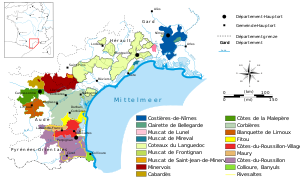Blanquette méthode ancestrale
The Blanquette méthode ancestrale is a French sparkling wine from Languedoc . It has been a vin d'appellation d'Origine Contrôlée (AOC) since February 18, 1938 . The AOC Blanquette méthode ancestrale was, together with the Blanquette de Limoux, the first AOC in the Languedoc wine-growing region.
A distinction is made between the Blanquette de Limoux brute and the Blanquette de Limoux according to the méthode ancestrale . In addition, a Crémant de Limoux has been marketed in the Limoux wine-growing region since 1990 .
Geography and climate
The appellation is located in the Aude department and the Languedoc-Roussillon region near the city of Limoux , in the west of the AOC Corbières . The southern slopes of the hills are reserved for the appellation and consist of a combination of lime-rich layered silicate and slightly pebbly soils.
Limoux's climate allows the production of white grape varieties. The area is influenced by the Mediterranean as well as the Atlantic Ocean, which ensure sufficient sunshine and well-distributed rainfall. In addition, the vineyards are located at a height of approx. 160 to 450 m, which means that day and night temperatures are more clearly delimited and the mean annual temperature is lower than in the nearby Narbonne .
history
Although the viticulture in Limoux has been documented in writing since 931, the first mention of sparkling wine was not made until 1531. Monks of the Abbey of Saint-Hilaire were already masters of the production of Blanquette de Limoux.
Grape varieties
The Blanquette méthode ancestrale is exclusively from the grape variety Mauzac grapes. The Chardonnay and Chenin Blanc grape varieties permitted in the Blanquette de Limoux are therefore prohibited.
Since an amendment to the law in 2004, the Crémant de Limoux contains 50 - 70% Chardonnay, 20 - 40% Chenin Blanc and max. 20% of the secondary varieties Mauzac and Pinot Noir . Thus, the 3 sparkling wines of the region are fundamentally different in their type.
Vinification
With the Blanquette Méthode ancestrale , only a single spontaneous fermentation takes place. After the must has drained from the wine press , the base wine is cooled down in coolable stainless steel tanks to a temperature of around 10 ° C. The alcoholic fermentation does not start immediately, but fifteen to twenty days later in order to better extract the aromas from the grape material. Then the single-stage slow fermentation begins, which can last until the end of January after the harvest. The must is fermented to such an extent that it still contains enough residual sugar for the production of the perlage. This stop of fermentation used to be achieved by the cool temperatures of winter.
The base wine is roughly filtered using kieselguhr and then bottled without adding any sugar or yeast. There, the further alcoholic fermentation takes place in closed bottles with the indigenous yeasts from the region and ends a few months later when the pressure in the bottles reaches 500 to 700 kPa. This creates completely natural sparkling wines, which have a great finesse due to the fine perlage and the nutmeg aromas. The sparkling wine contains less than 7 ° alcohol and some residual sugar.
Approved municipalities
In 3 amendments to the law between 1938 and 1955, 42 communes in the Aude département were authorized to produce Blanquette de Limoux: Alet-les-Bains , Ajac , Antugnac , Bouriège , Campagne-sur-Aude , Cassaignes , Castelreng , Cépie , Conilhac- de-la-Montagne , Couiza , Cournanel , Coustaussa , La Digne-d'Amont , La Digne-d'Aval , Espéraza , Fa , Festes-et-Saint-André , Gaja-et-Villedieu , Gardie , Ladern-sur- Lauquet , La Serpent , Limoux , Loupia , Luc-sur-Aude , Magrie , Malras , Montazels , Pauligne , Peyrolles , Pieusse , Pomas , Roquetaillade , Rouffiac-d'Aude , Saint-Couat-du-Razès , Saint-Hilaire , Saint -Polycarpe , Serres , Tourreilles , Vendémies , Villar-Saint-Anselme , Villebazy and Villelongue-d'Aude .
literature
- Jancis Robinson : The Oxford Wine Lexicon . 3. Edition. Gräfe and Unzer Verlag, 2007, ISBN 978-3-8338-0691-9 .
- Pierre Galet : Cépages et Vignobles de France . 1st edition. Lavoisier Publishing House, Paris 2004, ISBN 2-7430-0585-8 .
- Benoît France (ed.): Grand Atlas des Vignobles de France . 1st edition. Solar publishing house, Paris 2002, ISBN 2-263-03242-8 .
Web links
Individual evidence
- ↑ Official website of the Limoux appellation ( Memento des Originals of December 9, 2007 in the Internet Archive ) Info: The archive link was inserted automatically and has not yet been checked. Please check the original and archive link according to the instructions and then remove this notice.

